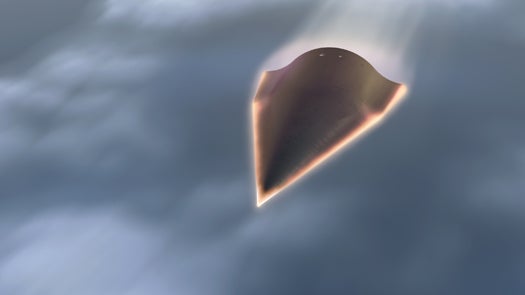Video: Last Year’s DARPA Hypersonic Glider Test Failed When Vehicle Sped Right Out of Its Own Skin
At 13,000 miles per hour, these things happen

After roughly eight months of crunching the data, DARPA has released its official report on exactly what happened to its Falcon Hypersonic Test Vehicle 2 (HTV-2), the Mach 20 test vehicle it launched into the atmosphere last summer only to lose contact with it nine minutes later. The conclusion: HTV-2 was moving so blisteringly fast that it tore right out of its own skin.
HTV-2 was launched as a hypersonic experiment, the second of its kind launched by DARPA (the first one, launched in 2010, failed to complete its flight as well) aimed at probing the heretofore unexplored envelope of hypersonic flight–flight at speeds higher than Mach 5, or five times the speed of sound. But HTV-2 wasn’t designed to explore the low end of the hypersonic realm. Notching speeds of 13,000 miles per hour, last summer’s flight of HTV-2 demonstrated three minutes of continuously stable flight at Mach 20 before its handlers lost contact with the vehicle.
At that point, DARPA gave us a few details regarding HTV-2’s prematurely terminated flight. Some kind of flight anomaly was encountered, the agency said, and the vehicle’s flight safety systems kicked in and put it into a controlled dive, just as they were designed to do. But the agency couldn’t tell us exactly what kind of anomaly the vehicle encountered, because presumably DARPA engineers themselves didn’t yet know.
Now, after months of review, DARPA has issued a statement describing what happened and what the agency has learned. In short, HTV-2 was tearing through the atmosphere at such a tick that its skin peeled away from the airframe, exposing gaps on the vehicles surface. At 13,000 miles per hour, these breaches in the vehicle’s carefully groomed aerodynamic exterior are highly problematic.
“The resulting gaps created strong, impulsive shock waves around the vehicle as it travelled nearly 13,000 miles per hour, causing the vehicle to roll abruptly,” DARPA said in a statement. “Based on knowledge gained from the first flight in 2010 and incorporated into the second flight, the vehicle’s aerodynamic stability allowed it to right itself successfully after several shockwave-induced rolls. Eventually, however, the severity of the continued disturbances finally exceeded the vehicle’s ability to recover.”
Perhaps the most interesting part of all this is that HTV-2 was able to right itself initially and re-stabilize its flight–it did, after all, fly for nine minutes total and three minutes at Mach 20, demonstrating that DARPA’s team is indeed honing its hypersonic skills. There are no more HTV flights currently on DARPA’s schedule, but the data gathered from this most recent attempt and the report recently issued on it will be carried further in ground testing of thermal uncertainties, new heat-withstanding materials, etc.
In other words, this isn’t over. The DoD and DARPA eventually want a vehicle that can reach any place on the planet in less than one hour (and presumably deliver some kind of as-yet undefined payload there). With a thicker skin, HTV-2 might just get there.
